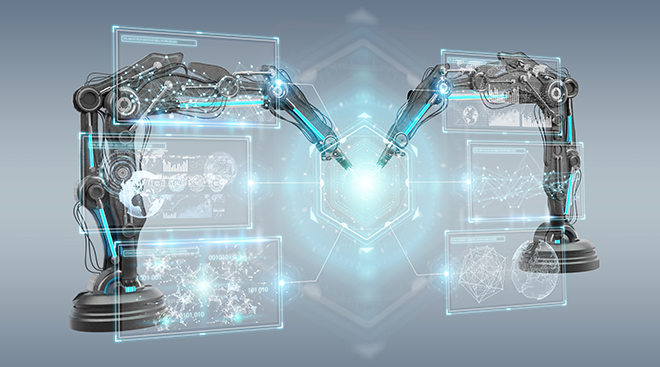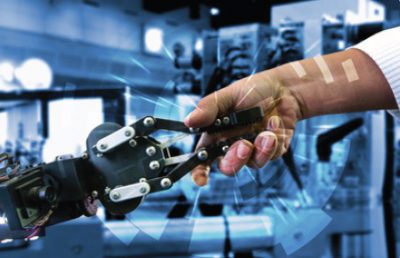Robotics
Robotics is a field that stands at the crossroads of mechanics, electronics and embedded computing. It covers a great diversity of use cases and is developing at a very fast past, offering a wide range of career opportunities.
What is robotics ?
Robotics includes the design, manufacturing and production of automatic machines or robots.
A robot is an actuated mechanism, on a fixed or mobile base, programmable in two or more axes with a certain degree of autonomy, moving within its environment, to perform intended tasks.
Autonomy in this context means the ability to perform intended tasks based on current state and sensing, without human intervention. (source : IFR)

Industrial robot
An industrial robot is a robot used for industrial production activities or related activities.
There are several types of industrial robots, depending on their technology : cartesian, scara, polyarticulated, parallel, etc. Robots are also distinguished according to their work situation with humans : for instance, collaborative robot applications (aka. cobots) have the purpose and effect of making humans and robots work on complementary tasks in a shared workspace.
Industrial robots can offer a wide range of applications: welding, painting, handling, loading, unloading, palletizing, bin picking, parts transport, logistics, shipping, cutting, assembly, deburring, etc. They also allow to perform tasks in harsh environmental conditions (toxic products, dust, for example) or involving a high degree of physical stress and strain (moving heavy loads, repetition of operations at high speed).
By extension, industrial robotics do not only refer to the robot, but also to an assembled unit including the robot (robotized production line, robotic cell, etc.).
Professional service robots
A professional service robot, also known as service robot for professional use, is a service robot used to perform a commercial task, and generally operated by a properly trained operator. For instance : cleaning robots in public spaces, delivery robots in logistics centers, offices or health centers, firefighting robots, rehabilitation robots, surgery robots in hospitals, etc.
In this context, we call ‘operator’ a person designated to start, monitor, and stop the intended operation of a robot or robot system.
A robot system is a system comprising robots, end-effectors and any machine, equipment, device or sensor supporting the robot performing its task.
Personal service robots
A personal service robot or personal use service robot is a service robot used to perform a non-commercial task, usually by lay people/general public.
Examples are domestic servant robot, vacuum cleaner robot, automated wheelchair, and personal mobility assistance robot.
Some personal service robots are called « humanoïds » because they have been designed to look and move like humans.
Robots can’t replace humans !
Robots are essential characters in science fiction, and their opponents often argue that, using Artificial Intelligence, robots could think and feel like humans and replace them, thus becoming a threat to humanity. Please let us tell you that it remains -and will remain- pure science fiction : the complexity and adaptability of the human brain, with includes billions of nervous combinations, is not comparable with an artificial intelligence program. This form of intelligence, which is only ‘intelligent’ by its name , cannot go beyond the limits of its program, which is created by humans. It is designed for specific and supervised tasks : any decision made by AI is nothing but the result of training to accomplish these tasks, and not at all an initiative of AI alone.
Robotics in Industry
Everywhere in the world, robotisation is an accelerating trend.
Especially in Industry, robotics is considered as an emblematic technology of the Industry of the Future. It is a fast developing production model that brings about lasting progress and performance increase : improvement of working conditions (reduction of musculoskeletal disorders or exposure to toxic / dangerous environments for production operators), reliability, production speed, etc. .
Robots don’t kill jobs !
Contrary to common perception, robotisation in the Industry does not delete jobs ! In fact, it even acts as a bulwark against relocation by helping to maintain an industrial production footprint in developed countries and protect production capacities.
Single tasks (often small and repetitive) assigned to robots allow for an enrichment of the operator’s work, who is thus able to focus on higher value added tasks. Several studies have proven that a company investing in a production robot enters a virtuous circle that even results in the creation of new jobs.
Robotics training : which career ?
The robotics field offers many exciting opportunities. Here are some examples of jobs that you can access with a robotics training :
- Robot cell supervisor: he/she ensures the proper functioning of the operating robot cell or assembly line.
- Service technician / after sale customer service: he/she detects and diagnosis the sources of disorder or failure, thus contributes to the improvement of robot systems.
- Robot programmer : he/she develops the program of the robot, its moves and their sequences.
- Sales engineer : he/she negotiates the sale of robotic solutions with customers.
- Mechanical engineering office engineer / technician : he/she writes down the technical specifications for subcontractors, draws detailed plans of peripheral equipments working with the robot, drives simulation tests of the robot/ robot cell / assembly line.
- Automation engineering office engineer /technician : he/she writes down the technical specifications for subcontractors, and design the automation solution.
- Robotics application engineer : he/she is a specialist of robotics and processes, imagine and suggest the best robot solution according to the client’s requirements.
- Robotics project manager : he/she manages the project from the initial order to the final acceptance by the customer (budget follow-up, team management, respect of deadlines and quality).
- Robotics researcher : he/she works by a Research Laboratory and contributes to the development of new robotic products and techniques.
This is a non-exhaustive list : as the Industry of the Future rises and new robotic solutions emerge, robotics and automation needs increase and a lot of jobs are concerned. Moreover, the best is yet to come : brand new exciting jobs will certainly appear in the coming years.
Want to know more ?
International Federation of Robotics
About Robotics and Artificial Intelligence

